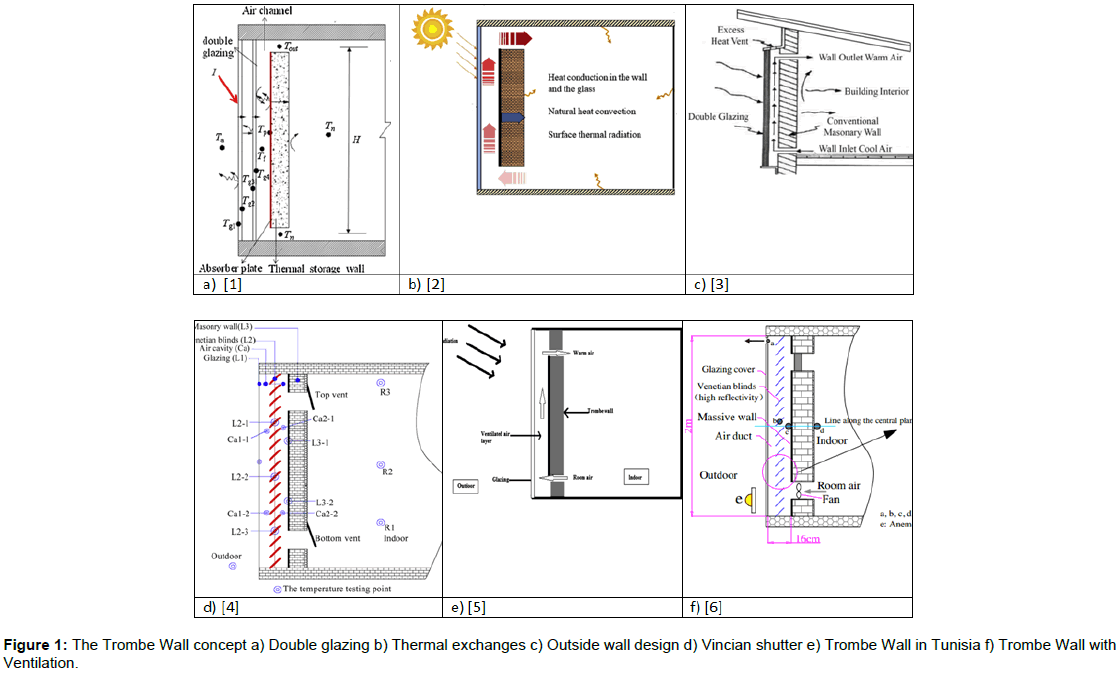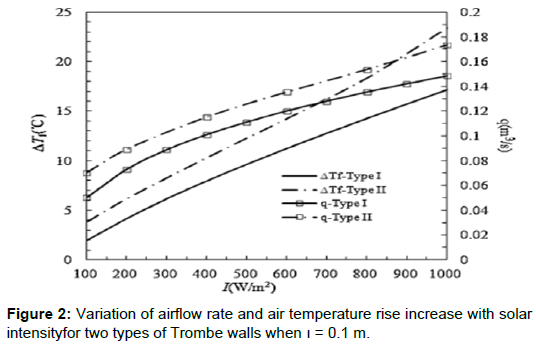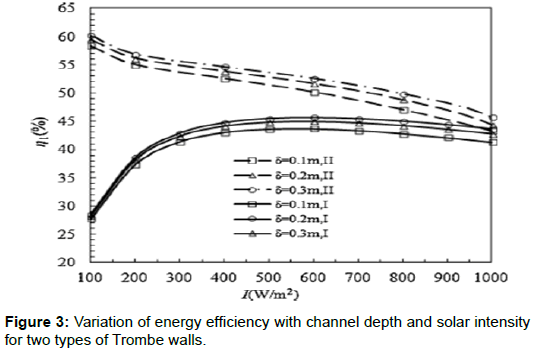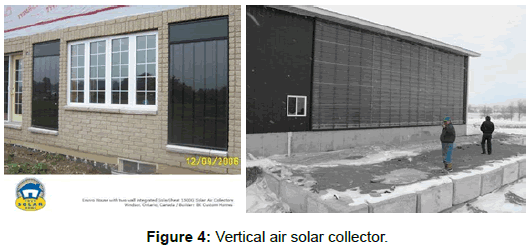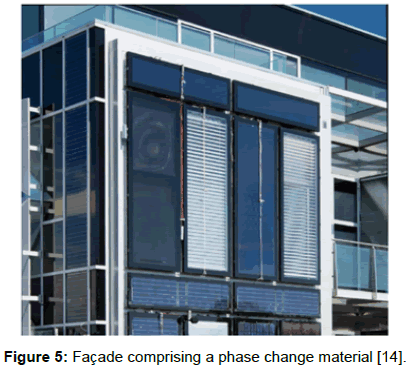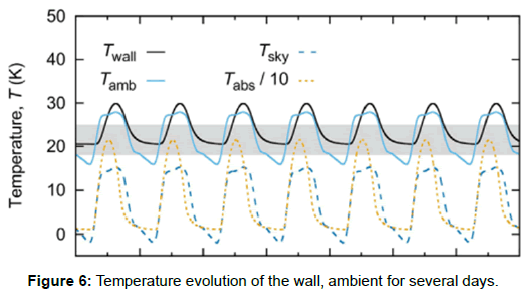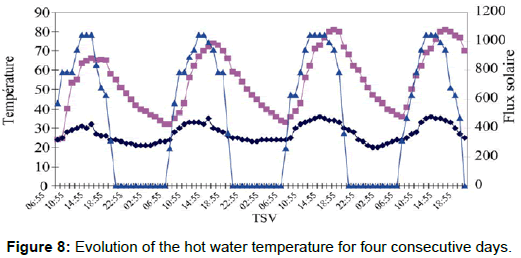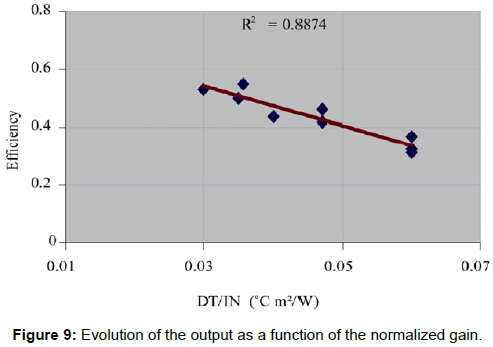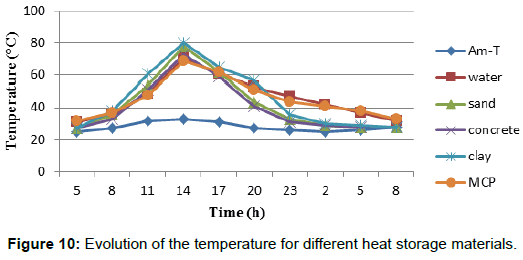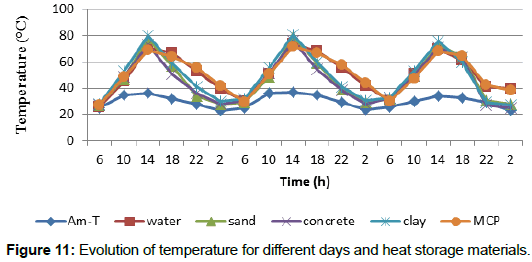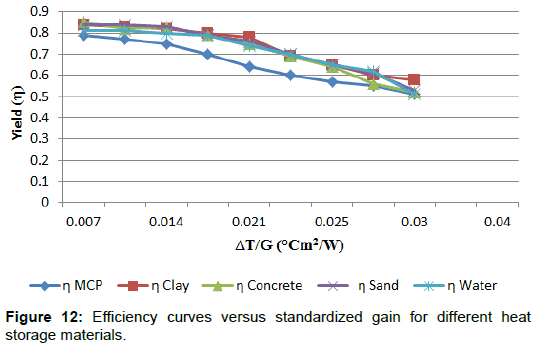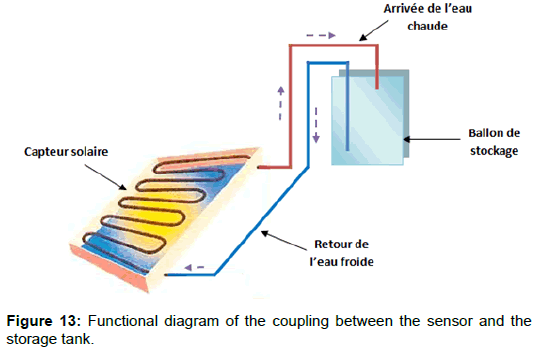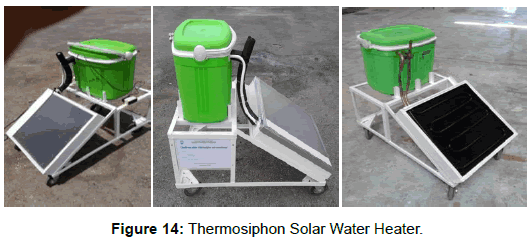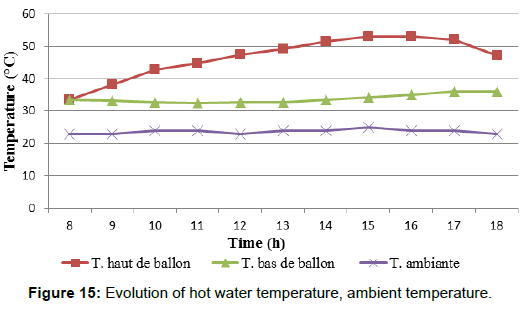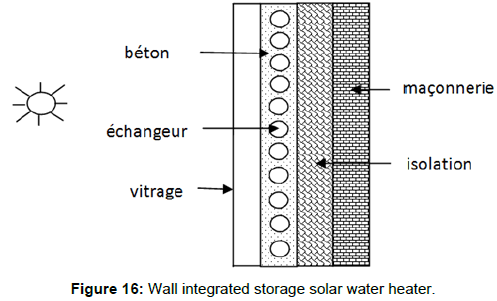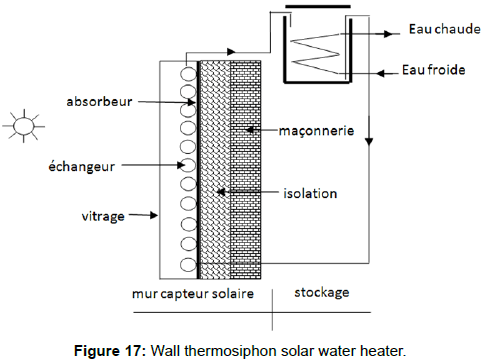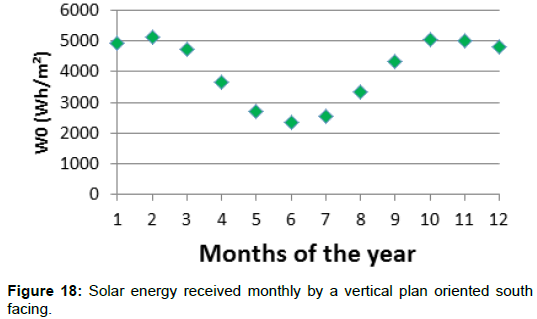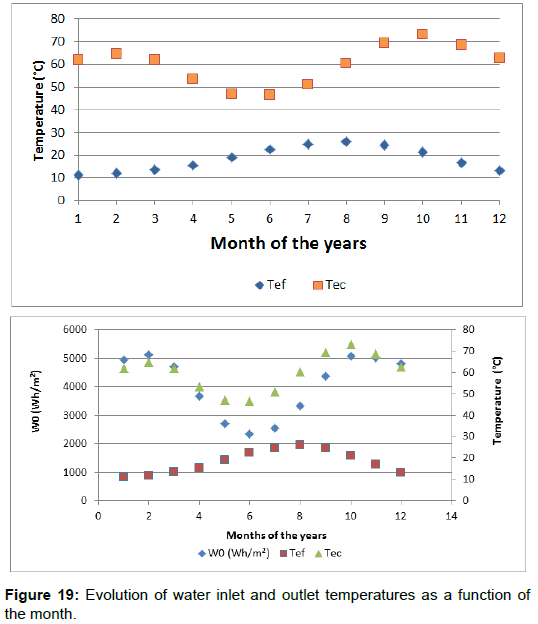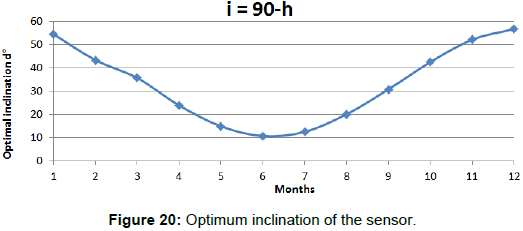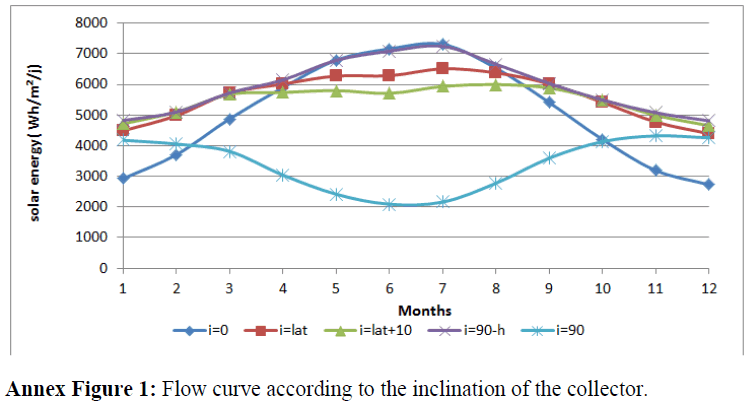Conception of Two Wall-Solar Water Heater
Received: 28-Apr-2018 / Accepted Date: 07-May-2018 / Published Date: 11-May-2018 DOI: 10.4172/2576-1463.1000202
Abstract
The design of the new type of solar water heater built into the façades did not come from chance. It relies on "prerequisites" and previous studies, namely a) knowledge of the constitution of the solar water heater with its two components solar collectors and storage b) The existence of the well-known Trombe wall concept, c) The façade heating itself formed by solar air collector, d) Our patented innovation since 1989 for the integrated storage solar water heater. The solar water heater type integrated storage solar collector is integrated to the wall facade to reduce the cost and to better intercept solar radiation in winter when the need for hot water are the most important. Moreover, to save hot water for several days, we rely on another concept which is the thermosiphon solar water heater that we have developed and innovated by removing all threaded connections and / or Internal soldering to the solar collector and storage of hot water, thus resulting in innovation of solar water heater wall with thermosiphon, where the collector is in the facade and storage inside. The solar water heating system performs well since a temperature of 64°C should be reached in winter.
Keywords: Vertical solar collectors; Trombe wall; Heating in winter
Introduction
Solar water heaters exist in Tunisia, operating mainly in thermosiphon. Forced circulation is preferred for cold regions or for collective installations. Although the solar energy is abundant, free and inexhaustible, it is not used in a massive way even in southern Tunisia.
However, it is observed that some handicaps inhibit the expansion of water heating by solar energy. Firstly, the high cost, even if the water heaters are subsidized, secondly they often break down and are not functional mainly because of the leaks, thirdly and not least, their performance is out of phase with the needs. Indeed, the needs are mostly in winter, when sunshine is naturally lower than in summer, but that is not all. Indeed, solar collectors are very often slightly sloping according to the rule: inclination latitude of the place (i = φ), or the solar rays are also low at midday, so that the solar collector receives very little solar energy. Hence the urgent need to raise the solar collector (having i> 45°) so that the solar rays are perpendicular to the plane of the solar collector at noon solar, and better benefit from the albedo.
On the basis of these findings, we have developed a solar water heater integrated into the vertical wall, mainly oriented south, in the manner of what is called the Trombe wall, which consists of a vertical air solar collector, Storage of the heat to restore it inside the room.
There are also a solar air collectors properly so-called, placed vertically, for the heating of the premises which takes place in winter, moreover, during this season the solar rays are the lowest in the year and thus, are well intercepted by the vertical plane.
In the present innovation, we will also use a vertical plane (wall) for water heating, because in Tunisia, the need for hot water is rather in winter.
Its design will be inspired by our integrated storage solar collector or thermosiphon developed in recent years [1-6] with as heat storage materials: sand, clay, concrete, MCP in addition to water. So in the same way as placing a vertical air solar collector or a Trombe wall, it is expected to place a solar water collector with or without storage in the wall and will be called WALL-WATER heater SLAMA.
Bibliographic Studies
From the standpoint of varieties of solar collectors, which can be used especially in winter, where the heating and hot water requirements are the highest, the choice of placing them vertically and integrated into the wall is a justified choice because solar rays are the lowest in winter, December, in the northern hemisphere (in summer for the southern hemisphere: June). Moreover, integrated in the wall, the cost of the water heater is reduced; the efficiency increased the same for the esthetics and the acceptability by the users. There are two known applications for vertical solar panels placed on the façade: the Trombe wall well known for passive solar heating and solar air collectors for active heating.
In summer, the situation is reversed, there is no more problem of heating, but rather refrigeration, something that will not be treated here. Thus, in the Nordic countries, as in winter, the sunshine is low because the sun's height is low, it is only possible to heat the air (because it is much lighter than water and requires a much higher heat mass low).
However, for countries in the south that are sufficiently sunny even in winter, it is possible to heat not only the air but also the water where the needs are highest in winter; Not really need heating premises because the cold winter period is short (compared to that of the summer quite warm). So it seems wise, as for the Trombe wall, to design vertical solar water heaters to better satisfy the needs of hot water in winter; in summer the problem of water heating does not arise seen favorable weather conditions and weaken the need for hot water during this summer season (Annex 1 and 2).
First concept: The wall Trombe
Trombe is the name of its inventor, a French engineer. This is the design of a wall playing the role of both solar collector and heat storage. Thus, this massive concrete wall painted from the outside in black, has openings at the top and bottom, for the natural circulation of the air, and is covered with glazing to benefit from the greenhouse effect (imprisonment of infrared radiation, while reducing convection losses with outdoor ambient air). The air on heating becomes lighter and mount, causing a depression at the low side which aspire air from the room and heats it. At the same time the wall radiates inside the room.
The Trombe wall is efficient because the heating needs are very important in winter, when the sun rays are low, so well intercepted and absorbed by the vertical plane.
In summer, to avoid overheating, it is necessary to protect it by the passing of the slab (also called cantilever) and the escape of the air is done towards the outside, on the upper side from the wall.
Various works on the Trombe wall have been carried out, the most recent of which evoke the place of air flow: between the glass and the wall or between the wall and an interior insulation, the number of panes, with or without insulation, Awning and orifices of air maneuverable or not (Figure 1) [1-13].
The results of Duana studies [1] and other authors show the temperature and efficiency performances of the Trombe wall as a function of solar energy. Some encouraging results (Figures 2 and 3).
Second concept: Solar air collectors placed on facades
The solar collectors installed on the facade are available. They are compact, warm in winter, cold season, because the solar rays are low (h=90- φ -23°,45 on 21th December), then well intercepted by the vertical plane [14,15].
Result of measurements:
These curves show the influence of vertical wall heating, especially if it includes a phase change material according to (Figures 4-6) [14].
Figure 5: Façade comprising a phase change material [14].
Third concept: The integrated solar collector ISC
We have designed, studied and tested this integrated storage solar collector since 1989. Since then, it has been patented and has received a BSB award. This solar collector is distinguished from existing water heaters by its reduced cost since it consists of only one element acting as a dual solar collector and heat storage. The temperature level is also higher, and so is the efficiency. The downside is its nocturnal cooling. Its use is therefore to be advocated the same day, and better still during the afternoon. The heat storage initially made through the water was then replaced by other materials that do not cause corrosion of the tank and thus extend the life of the solar water heater, such as sand, clay, concrete and PCM (phase change material such as paraffin wax, margarine, etc.) [16-18].
The results of the measurements performed on this type of integrated storage solar collector are shown in Figures 7-12.
Figure 8 shows the temperature of the water during heating and night cooling as well as the ambient temperature and the sunshine.
Figure 9 shows the evolution of the efficiency as a function of the normalized gain. As for Figures 10 and 11 show the evolution of the temperature of the hot water for the various thermal storage materials tested: concrete, sand, clay, MCP and water. The temperature of the water reaches 80°C at an ambient temperature of 35°C, a temperature rise of 45°C, which is appreciable.
Figure 10 shows the evolution of the temperature for different heat storage materials and Figure 11 shows the evolution of temperature for different days and heat storage materials.
Figure 12 shows the variation of the efficiency as a function of the normalized gain. Thus, for a gain of 0.007 m2°C/W, the yield is about 80%. This yield is still 50% to 58% depending on the material and for a gain of 0.030 m2°C/W.
Figures 9 and 12 complement each other, the first for large gains (>0.03 m2°C/W) and the second for the lower ones (<0.03 m2°C/W).
This solar collector can be installed vertically and integrated with a façade to heat well in winter, be manufactured on site by the mason if the storage is of concrete poured on site on the heat exchanger.
Fourth concept: The thermosyphon solar water heater
We have designed, studied and tested this type of solar water heater for a few years, and a patent application has been filed.
Context: In order to remedy the nocturnal cooling encountered in the case of the ISC, the thermosiphon type water heater (or even forced circulation) is now also interested, but with an innovation that makes it possible to extend the life of the heat- water. This innovation eliminates any problem of corrosion and leakage which are the main cause of deterioration of solar water heaters. Firstly the metal tank will be replaced by plastic (use of standard icebox, converted therefore into boiler, thus simplifying the construction). Secondly and most importantly, any internal connection by soldering or connection with the storage tank will be eliminated. Thus, the return of the water from the solar collector to the storage will take place from the top of the storage tank. And above all, the return of the water from the storage to the solar collector will not be done, not in a conventional way, from the bottom directly from the storage to the collector, but by going up the storage wall then descending towards the solar collector.
However, the connection between the two parts; solar collector and storage can be done in the same conduits that connect them, either by threading or by welding.
Figure 13 shows the diagram of the operating principle of the thermosiphon water heater without internal connection neither in the collector nor in the storage tank for hot water (Figure 14).
Figure 15 shows the evolution of the water temperature inside the storage tank as well as the ambient temperature. The temperature rise of the water reaches 30°C relative to the ambient temperature here.
Solar Water Heater Integrated in a Building Facade
From the four concepts discussed previously concerning the heating of air and water, we conceive here the integration of the water heater with the vertical facade of buildings in two configurations: integrated storage solar collector and thermosiphon.
Solar water heater with integrated storage, placed on the front for use on the day
For the winter, as the solar rays are low, a vertical plane (wall) can very well intercept the solar radiation, with in addition being aesthetic and integrated to one of the facades. On the other hand, to reduce the cost of the solar water heater and to generalize its application even in the less well-off social strata, we design a type of solar water heater unconventional, but built locally by the mason even during construction of the premises, in the manner of Figure 16. This concept consists of placing an insulating plate in front of the wall followed by storage in masonry or concrete, and finally a glazing for benefiting from a greenhouse.
The use of hot water is here for the same day. This solar collector gives warm water during the day, but night cooling prevents it from keeping its heat stored for a long time during the day. To remedy this, one can return to conventional storage with circulation in thermosiphon (or forced) but with an innovation, in order to avoid breakdowns and thus maintenance. The longevity is significantly extended as follows.
Solar water heater with separate storage in thermosiphon circulation, placed on the front
To reduce night cooling, it is possible to separate the hot water storage tank from the collector and place the balloon inside as in cold countries. In addition, to minimize maintenance, all connections (welding and threading) inside the solar collector and the balloon will be avoided. The use of hot water is here extended for a few days without significant cooling.
The Figure 17 shows the operating principe of a thermosiphon solar water heater whose collector is integrated into the wall and the storage tank can be placed inside to reduce its cooling.
Temperature predictions
To find the temperature reached by the heated water according to the month of the year for a solar collector located on façade oriented to the south, the energy balance of the water heater is written, which consists in balancing the heating energy of the " Water and that from the sun, at the conversion efficiency near:



M: equivalent mass of water to be heated (50 kg)
W0: solar energy received per day kWh/m2/j [19]
S: surface of capture area m2
ƞ: Conversion efficiency (taken as 60% because the rear losses of the solar collector are low as the heat exchange is no longer with outside air, cold in winter but rather with indoor air in the room).
Tef: Average night water temperature: taken as the initial temperature because the heating of the water starts in the morning and continues during the day.
Tec: temperature of the hot water at the end of the day.
The results are shown in Table 1 and Figures 18-20 for the Gabes region, Tunisia.
| Month | Jan. | Feb. | March | April | May | June | July | August | Sept. | Oct. | Nov. | Dec. |
|---|---|---|---|---|---|---|---|---|---|---|---|---|
| W0 | 4929 | 5120 | 4717 | 3657 | 2716 | 2353 | 2556 | 3339 | 4356 | 5060 | 5027 | 4811 |
| T ef | 11.3 | 12 | 13.6 | 15.7 | 19.1 | 22.4 | 24.8 | 26.1 | 24.6 | 21.2 | 16.9 | 13.1 |
| Tec | 62 | 64.7 | 62.1 | 53.3 | 47 | 46.6 | 51.1 | 60.5 | 69.4 | 73.3 | 68.6 | 62.6 |
Table 1: Value of solar energy daily received (Wh/(m2.j) and cold and hot water temperature.
Interpretation
Since the solar collector is a vertical wall, it is logical that the flow intercepted in summer is lower than in winter because the height of the sun is at its maximum during this summer period. However, the temperature of cold water in the morning, although minimal, increases from winter to summer. On the other hand in summer, the need for hot water is lower than in winter, so the temperatures to be reached would be higher. Conversely, the temperature level required in summer is often not high, so the amount of warm water would be more than 50 l/m/j.
Conclusion
The integration of the heating of the sanitary water in the building façade therefore applies in the same way as the Trombe wall or the heating of the premises by the facades. Given the high sunshine in southern Tunisia, with a fraction of sunshine already reached in February 70%, the system can only be performing. By having a fairly low sunshine in January (the coldest month), the vertical wall will intercept them and thus transmit heat to the water to be heated. During the hot summer period from May to September, the perception of solar radiation is reduced due to the obliquity of the solar rays to the vertical plane of the wall, but this does not alter the Temperature reached by the water because the climatic conditions are favorable and the needs of hot water weaken [19-21].
References
- Duana S, Jing C, Zhaoa Z (2016) Energy and exergy analysis of different Trombe walls. Energ Buildings 126: 517-523.
- Opez HL, Xaman J, Chavez Y, Hernandez-Perez I, Alvarado-Juarez R (2016) Thermal energy storage and losses in a room-Trombe wall system located in Mexico. Energ 109: 512-524.
- Modirroustaa S, Boostanib H (2016) Analysis of Atrium Pattern, Trombe Wall and Solar Greenhouse on. Procedia Engineering 145: 1549-1556.
- He W, Hu Z, Luo B, Hong X, Sun W, et al. (2015) The thermal behavior of Trombe wall system with venetian blind: An experimental and numerical study. Energ Buildings 104: 395-404.
- Abbassi F, Dimassi N, Dehmani L (2014) Energetic study of a Trombe wall system under different Tunisian building configurations. Energ Buildings 80: 302-308.
- Hua Z, He W, Honga X, Ji J, Shen Z (2016) Numerical analysis on the cooling performance of a ventilated Trombe wall combined with venetian blinds in an office building. Energ Buildings 126: 14-27.
- Liu Y, Wang D, Ma C, Liu J (2013) A numerical and experimental analysis of the air vent management and heat storage characteristics of a trombe wall. Solar Energ 91: 1-10.
- Saadatian O, Sopian K, Lim CH, Asim N, Sulaiman MY (2012) Trombe walls: A review of opportunities and challenges in research and development. Renew Sust Energ Rev 16: 6340-6351.
- Briga-Sá A, Martins A, Boaventura-Cunha J, Lanzinhaa JC, Paivaa A (2014) Energy performance of Trombe walls: Adaptation of ISO 13790:2008(E) to the Portuguese reality. Energ Buildings 74: 111-119.
- Zhou G, Pang M (2015) Experimental investigations on thermal performance of phase change material e Trombe wall system enhanced by delta winglet vortex generators. Energ 93: 758-769.
- Bellos E, Tzivanidis C, Zisopoulou E, Mitsopoulos G, Antonopoulos KA (2016) An innovative Trombe wall as a passive heating system for a building in Athens- A comparison with the conventional Trombe wall and the insulated wall. Energ Buildings 133: 754-769.
- Dabaieh M, Elbably A (2015) Ventilated Trombe wall as a passive solar heating and cooling retrofitting approach; a low-tech design for off-grid settlements in semi-arid climates. Solar Energ 122: 820-833.
- Abbassi F, Dehmani L (2015) Experimental and numerical study on thermal performance of an unvented Trombe wall associated with internal thermal fins. Energ Buildings 10: 119-128.
- Hengstberger F, Zauner C, Reschb K, Holper S, Grobbauer M (2016) High temperature phase change materials for the overheating protection of facade integrated solar thermal collectors. Energ Buildings 124: 1-6.
- Visa I, Duta A, Comsit M, Moldovan M, Ciobanu D, et al. (2015) Design and experimental optimisation of a novel flat plate solar thermal collector with trapezoidal shape for facades integration. Appl Therm Eng 90: 432-443.
- Ben Slama R (2010) Experimentation of a plane solar integrated collector storage water heater. International Renewable Energy Congress pp: 395-403.
- Ben Slama R (2012) Experimentation of a Plane Solar Integrated Collector Storage Water Heater. Energy and Power Engineering, Scientific Research 4: 67-76.
- Ben Slama R (2014) Comparative study between three solar water heaters according to the integrated storage type: water, sand and concrete. Machines Review 1: 28-33.Â
- Ben Slama R (2013) Incidental Solar Radiation on the Various Walls of a Building. Thermal Energy and Power Engineering.
- Kalogirou SA, Florides G, Tsioutis C, Christofi C. Modular Building Intergraded Solar-Thermal Flat Plate Hot Water Collectors.
Annex 1
| J | F | M | Ap | M | J | Jy | Au | S | O | N | D | |
|---|---|---|---|---|---|---|---|---|---|---|---|---|
| i=0 horizon. | 2990 | 4990 | 6668 | 7934 | 9038 | 9403 | 9261 | 8392 | 6501 | 4622 | 3852 | 2696 |
| 3392 | 4540 | 6335 | 7922 | 9029 | 9493 | 8474 | 8411 | 3410 | ||||
| 2781 | 3632 | 5171 | 6414 | 7584 | 8174 | 7872 | 7654 | 2833 | ||||
| 2924 | 3704 | 4875 | 5896 | 6792 | 7160 | 7309 | 6534 | 5411 | 4202 | 3191 | 2727 | |
| i = latitude | 4852 | 6530 | 6725 | 8006 | 7939 | 8246 | 7882 | 8003 | 7601 | 6258 | 5189 | 4543 |
| 5333 | 6143 | 6271 | 7889 | 7931 | 7825 | 7876 | 8013 | 5223 | ||||
| 4373 | 4914 | 5025 | 6311 | 6662 | 6729 | 7319 | 7292 | 4330 | ||||
| 4486 | 4980 | 5720 | 6011 | 6276 | 6286 | 6510 | 6380 | 6021 | 5417 | 4775 | 4391 | |
| i = latitude+10 | 5128 | 4825 | 6749 | 7748 | 7457 | 7951 | 7343 | 8491 | 7337 | 6376 | 5963 | 4830 |
| 5529 | 6281 | 7534 | 7439 | 5704 | 7642 | |||||||
| 4533 | 5025 | 6027 | 6243 | 4905 | 6954 | |||||||
| 4716 | 5102 | 5675 | 5739 | 5801 | 5711 | 5938 | 5998 | 5886 | 5493 | 4994 | 4655 | |
| i optimal (90-h) | 54.6 | 43.45 | 35.75 | 23.92 | 14.95 | 10.75 | 12.55 | 20.15 | 36.85 | 42.6 | 52.25 | 56.85 |
| 5264 | 6627 | 6918 | 8094 | 8290 | 8362 | 8341 | 8180 | 7605 | 6371 | 6022 | 4996 | |
| 5589 | 6286 | 8028 | 8282 | 8358 | 8181 | |||||||
| 4583 | 5029 | 6422 | 6956 | 7188 | 7445 | |||||||
| 4827 | 5099 | 5722 | 6147 | 6788 | 7086 | 7244 | 6664 | 6034 | 5491 | 5078 | 4814 | |
| I=90 vertical | 4518 | 4872 | 4533 | 4104 | 3171 | 2684 | 2871 | 3729 | 3698 | 3690 | 4594 | 4342 |
| 4510 | 4833 | 3458 | 3158 | 2193 | 3725 | |||||||
| 3698 | 3866 | 2766 | 2653 | 1886 | 3390 | |||||||
| 4181 | 4055 | 3815 | 3043 | 2418 | 2090 | 2161 | 2776 | 3595 | 4133 | 4322 | 4258 |
Annex Table 1: Solar energy incident by clear sky according to the angle of inclination of the solar collector.
| J | F | M | Av | M | J | Jy | Ao | S | O | N | D | |
|---|---|---|---|---|---|---|---|---|---|---|---|---|
| i = 0 horizon. | 2924 | 3704 | 4875 | 5896 | 6792 | 7160 | 7309 | 6534 | 5411 | 4202 | 3191 | 2727 |
| i = latitude | 4486 | 4980 | 5720 | 6011 | 6276 | 6286 | 6510 | 6380 | 6021 | 5417 | 4775 | 4391 |
| i = latitude+10 | 4716 | 5102 | 5675 | 5739 | 5801 | 5711 | 5938 | 5998 | 5886 | 5493 | 4994 | 4655 |
| i optimale (90-h)pour ID | 54.6 | 43.45 | 35.75 | 23.92 | 14.95 | 10.75 | 12.55 | 20.15 | 30.85 | 42.6 | 52.25 | 56.85 |
| 4827 | 5099 | 5722 | 6147 | 6788 | 7086 | 7244 | 6664 | I 6034 | I 5491 | I 5078 | 4814 | |
| I=90 vertical | 4181 | 4055 | 3815 | 3043 | 2418 | 2090 | 2161 | 2776 | 3595 | 4133 | 4322 | 4258 |
Annex Table 2: Solar energy received by a solar collector as a function of the month and for different inclinations.
Interpretation:
For a horizontal inclination, in the case of the roof, the incident energy increases from winter to summer, inversely for vertical inclination.
For an inclination equal to the latitude of the place (i=φ, the contrast of the results is not as much as with the horizontal position, but the rate of evolution is comparable.
For an inclination equal to the latitude of the place increased by 10 (i= φ+10), the incident energy is better in winter and lower in summer compared to i= φ; the values are almost constant over all Year.
Obviously for the optimum inclination (i = 90-h), the incident energy is the highest, but it is necessary to modify the inclination every month, which is not particularly convenient for individual solar water heaters.
For vertical inclination, in the case of walls, the maximum incident energy is in winter, when heating and hot water requirements are highest in the year, for these applications, there is no objection in summer.
Annex 2
Analogy between the normalized gain and the thermal resistance:
Noting that the normalized gain taken as the abscissa axis in the performance curves of solar water heaters (ΔT/IN) has the same unit as the thermal resistance of the material (e/λ) ie: the m2.°C.W-1.
The analogy is that to achieve a certain value of the normalized gain, therefore a rise in temperature of the heat-transfer fluid, there must be a thermal transfer capable of overcoming the thermal resistance by convection between the fluid and the absorber in the case of the air or water solar collectors.
The thermal resistance with the heat transfer fluid affects its temperature rise.
Citation: Slama RB, Ellasoued R (2018) Conception of Two Wall-Solar Water Heater. Innov Ener Res 7: 202. DOI: 10.4172/2576-1463.1000202
Copyright: © 2018 Slama RB, et al. This is an open-access article distributed under the terms of the Creative Commons Attribution License, which permits unrestricted use, distribution, and reproduction in any medium, provided the original author and source are credited.
Share This Article
Recommended Journals
Open Access Journals
Article Tools
Article Usage
- Total views: 4619
- [From(publication date): 0-2018 - Nov 25, 2024]
- Breakdown by view type
- HTML page views: 3937
- PDF downloads: 682

